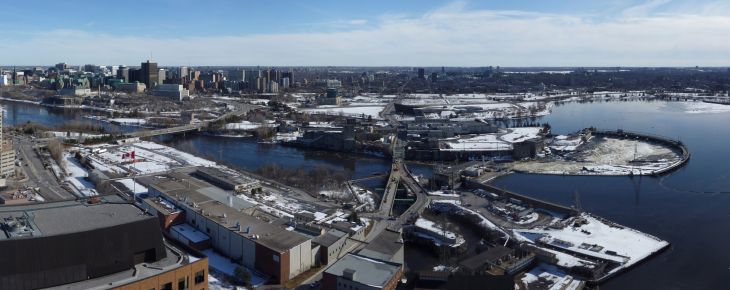

During the decades-long (and still raging) debate about the fate of the Victoria & Chaudière Islands Historic District, many voices were heard calling for cultural expression, “art for the people” and preservation of the Cultural Heritage Landscape, that is “The Chaudière”.
The Harper-era Treasury Board turned down the NCC when it went cap in hand to execute their long-considered and thoughtfully-developed business plan and the MTBA-authored District Design Master Plan when it had its best opportunity in generations – Domtar finally pulling out and willing to sell its sizable portion of the land.
The Domtar Lands were eventually purchased by Windmill Developments in partnership with Dream Properties and their mixed-use Zibi development was the first to be approved jointly by Ottawa, Gatineau and the NCC, quite a feat of bureaucracy-busting that should have lessons for future waterfront opportunities. Zibi is a singular opportunity, now well underway, to mixed early reviews but somewhat positive.
That leaves it (mostly) up to the NCC, who are charged with planning the remining lands in the district (mostly Victoria and Amelia Islands, plus Richmond Landing Area on the Ontario shore) to ensure the content that is (somewhat) lacking in Zibi – cultural expression, “art for the people” in quality public space and preservation of the Cultural Heritage Landscape. The bona fide First Nations issues, as challenging as they are, are only part of the equation. The NCC has begun well – plans for revitalizing the area around Mill Street Brew Pub (Bronson Pulp Mills Ruins and Richmond Landing or BPMRRL) and execution of the Indigenous Pavilion in the old Bronson Office addition (Kabeshinân Minitig) are both small early winners.
For example, their objectives for the BPMRRL project are directly and precisely taken from the 1990 MTBA Islands Master Plan for the NCC, as follows:
- To provide public access to the shoreline for pedestrians and cyclists.
- To provide universally accessible routes via new pathways.
- To provide docking access at Richmond Landing from the Ottawa River.
- To stabilize and enhance the Bronson Pulp Mill ruins as an industrial heritage site.
- To develop interpretation on our industrial, natural and settlement heritage, and include lookouts and wayfinding signage.
Where will it go from here? One idea is the 2011-2015 concept that says we must interpret this complex site, with its many layers of cultural heritage value and stunning location in the heart of the Nation’s Capital, on sacred islands in the Great River, in the shadow of Parliament Hill, in a way only great artists can – through the MTBA Initiative VisionChaudière .
While the chance for developing this public art-rich interpretive park for Canada 150 has slipped away, there is no reason why it could not be created for Canada 155…..As Lisa Prosper (former advisory board member for VisionChaudière, now an internationally-respected Cultural Landscape Expert and Fellow of the Canadian Geographic Society) once said, “Thank God for the Artists!” Providing opportunity for cultural interpretation and expression into this multi-layered landscape is most appropriate – the question is, how do you do that? VisionChaudière is one model…..but it is sleeping right now…….
 Wordpress
Wordpress





